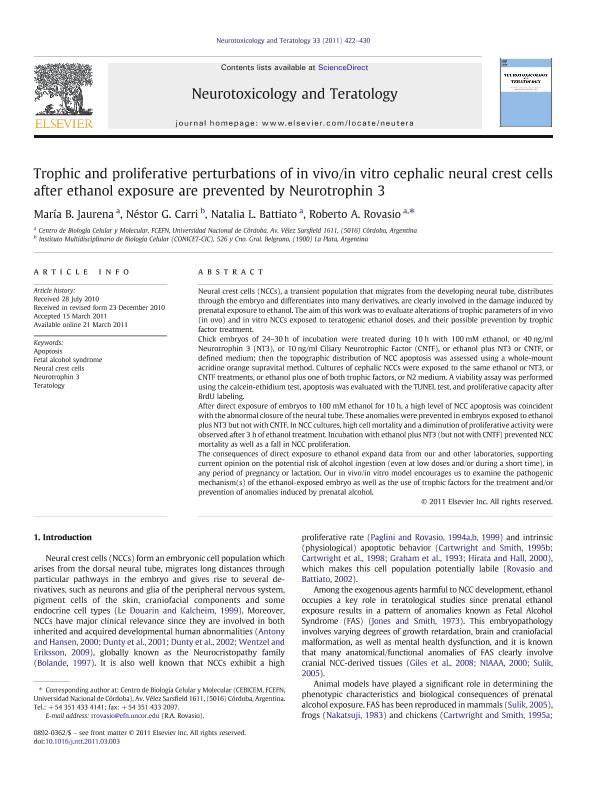Artículo
Trophic and proliferative perturbations of in vivo/in vitro cephalic neural crest cells after ethanol exposure are prevented by Neurotrophin 3
Fecha de publicación:
05/2011
Editorial:
Pergamon-Elsevier Science Ltd
Revista:
Neurotoxicology and Teratology
ISSN:
0892-0362
Idioma:
Inglés
Tipo de recurso:
Artículo publicado
Clasificación temática:
Resumen
Neural crest cells (NCCs), a transient population that migrates from the developing neural tube, distributes through the embryo and differentiates into many derivatives, are clearly involved in the damage induced by prenatal exposure to ethanol. The aim of this work was to evaluate alterations of trophic parameters of in vivo (in ovo) and in vitro NCCs exposed to teratogenic ethanol doses, and their possible prevention by trophic factor treatment. Chick embryos of 24–30 h of incubation were treated during 10 h with 100 mM ethanol, or 40 ng/ml Neurotrophin 3 (NT3), or 10 ng/ml Ciliary Neurotrophic Factor (CNTF), or ethanol plus NT3 or CNTF, or defined medium; then the topographic distribution of NCC apoptosis was assessed using a whole-mount acridine orange supravital method. Cultures of cephalic NCCs were exposed to the same ethanol or NT3, or CNTF treatments, or ethanol plus one of both trophic factors, or N2 medium. A viability assay was performed using the calcein-ethidium test, apoptosis was evaluated with the TUNEL test, and proliferative capacity after BrdU labeling. After direct exposure of embryos to 100 mM ethanol for 10 h, a high level of NCC apoptosis was coincident with the abnormal closure of the neural tube. These anomalies were prevented in embryos exposed to ethanol plus NT3 but not with CNTF. In NCC cultures, high cell mortality and a diminution of proliferative activity were observed after 3 h of ethanol treatment. Incubation with ethanol plus NT3 (but not with CNTF) prevented NCC mortality as well as a fall in NCC proliferation. The consequences of direct exposure to ethanol expand data from our and other laboratories, supporting current opinion on the potential risk of alcohol ingestion (even at low doses and/or during a short time), in any period of pregnancy or lactation. Our in vivo/in vitro model encourages us to examine the pathogenic mechanism(s) of the ethanol-exposed embryo as well as the use of trophic factors for the treatment and/or prevention of anomalies induced by prenatal alcohol.
Archivos asociados
Licencia
Identificadores
Colecciones
Articulos(CCT - CORDOBA)
Articulos de CTRO.CIENTIFICO TECNOL.CONICET - CORDOBA
Articulos de CTRO.CIENTIFICO TECNOL.CONICET - CORDOBA
Articulos(IIBYT)
Articulos de INSTITUTO DE INVESTIGACIONES BIOLOGICAS Y TECNOLOGICAS
Articulos de INSTITUTO DE INVESTIGACIONES BIOLOGICAS Y TECNOLOGICAS
Articulos(IMBICE)
Articulos de INST.MULTIDISCIPL.DE BIOLOGIA CELULAR (I)
Articulos de INST.MULTIDISCIPL.DE BIOLOGIA CELULAR (I)
Citación
Jaurena, María Belén; Carri, Nestor Gabriel; Battiato, Natalia Laura; Rovasio, Roberto Americo; Trophic and proliferative perturbations of in vivo/in vitro cephalic neural crest cells after ethanol exposure are prevented by Neurotrophin 3; Pergamon-Elsevier Science Ltd; Neurotoxicology and Teratology; 33; 3; 5-2011; 422-430
Compartir
Altmétricas




